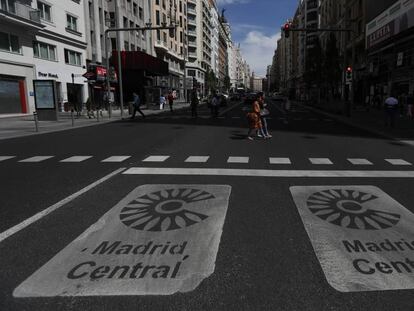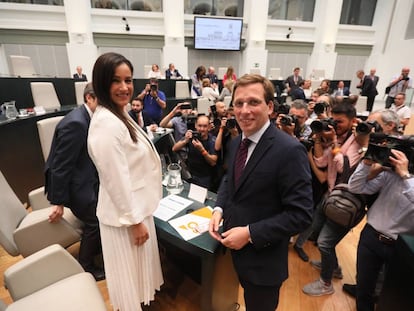Madrid Central considered one of the most effective anti-pollution plans in the EU
The low-emissions zone in the center of the Spanish capital has seen a 32% reduction in nitrogen dioxide emissions, according to a new report

The Madrid Central low-emissions zone has been described as one of the most effective plans in the European Union for the reduction of nitrogen dioxide. That’s according to a new report from the European federation of environmental associations, Transport & Environment (T&E). According to the study, emissions of the greenhouse gas have fallen 32% thanks to the initiative, which made 4.7 square kilometers of the city center off-limits to traffic, except for local residents and public transportation. This figure, however, is taken from the only measuring station within the low-emissions zone.
Toxic air is estimated to decrease life expectancy of every European by an average of almost one year
T&E report
Madrid Central was introduced under the former leftist administration of Mayor Manuela Carmena at the end of 2018. The current mayor of Madrid, José Luis Martínez-Almeida from the right-wing Popular Party (PP), tried to suspend the plan when he took office in June, but was blocked by the courts, which argued that the measure was needed to stop pollution from rising “without any kind of control.” The plan remains in place and drivers who enter low-emissions zones without the proper permissions are fined €90, or €45 if the amount is paid immediately.
The report says that greater awareness of the problems associated with pollution has led all European cities to introduce or strengthen low-emissions zones that are off-limits to polluting vehicles. “More than 250 EU cities have already taken such measures,” according to the study, which pointed out that “toxic air is estimated to decrease life expectancy of every European by an average of almost one year.”
The report also added that 67% of EU citizens interviewed either “strongly” or “somewhat” support the introduction of low-emissions zones.
A rise in fines
Fines for entering Madrid Central without authorization soared from 13,361 in May – when municipal elections were held – to 79,908 in June, according to local registers. That is a sixfold rise, which Mayor José Luis Martínez-Almeida said is proof that his predecessor Manuela Carmena “and her team did not believe in Madrid Central.”
“What they wanted was a propaganda tool to help them win the election,” said the Popular Party (PP) mayor on Monday. The previous governing team says it opted for a gradual rollout of penalties, and the goal was not so much sanctioning drivers as reducing pollution.
According to Nuria Blázquez, the transportation coordinator of the environmental group Ecologists in Action, which belongs to T&E, the main problem is that there is no clear “legal definition” of what is a low-emissions zone. The term could be applied to areas with strict restrictions or those with very little effectiveness. “That is the case, for example, in German cities, where there are only restrictions against the oldest vehicles, and there has been no change [in pollution levels],” says Blázquez.
The reason why Madrid Central is so effective is that only cars with a zero-emission tag can enter the low-emissions zone. All other vehicles (with some exceptions) must stay outside the area, which dissuades drivers from taking to the most central roads.
The T&E report argues that low-emissions zones are key to the effectiveness of anti-pollution measures but says that neither Madrid nor any other mayor European city have met the EU limits on air pollution.
English version by Melissa Kitson.
Tu suscripción se está usando en otro dispositivo
¿Quieres añadir otro usuario a tu suscripción?
Si continúas leyendo en este dispositivo, no se podrá leer en el otro.
FlechaTu suscripción se está usando en otro dispositivo y solo puedes acceder a EL PAÍS desde un dispositivo a la vez.
Si quieres compartir tu cuenta, cambia tu suscripción a la modalidad Premium, así podrás añadir otro usuario. Cada uno accederá con su propia cuenta de email, lo que os permitirá personalizar vuestra experiencia en EL PAÍS.
¿Tienes una suscripción de empresa? Accede aquí para contratar más cuentas.
En el caso de no saber quién está usando tu cuenta, te recomendamos cambiar tu contraseña aquí.
Si decides continuar compartiendo tu cuenta, este mensaje se mostrará en tu dispositivo y en el de la otra persona que está usando tu cuenta de forma indefinida, afectando a tu experiencia de lectura. Puedes consultar aquí los términos y condiciones de la suscripción digital.
More information
Archived In
Últimas noticias
Most viewed
- Sinaloa Cartel war is taking its toll on Los Chapitos
- Oona Chaplin: ‘I told James Cameron that I was living in a treehouse and starting a permaculture project with a friend’
- Reinhard Genzel, Nobel laureate in physics: ‘One-minute videos will never give you the truth’
- Why the price of coffee has skyrocketed: from Brazilian plantations to specialty coffee houses
- Silver prices are going crazy: This is what’s fueling the rally










































